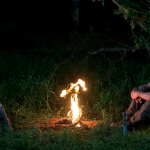On March 3, History Channel premiered its much-discussed miniseries The Bible, which proved to be thoroughly popular both on its original airdates and now on DVD. But what intrigued me more was the show that followed The Bible’s premiere, History Channel’s first original fictional series, Vikings. The series ended its inaugural season this Sunday but will return for a second season sometime in 2014. The brainchild of former Tudors scribe Michael Hirst, Vikings follows the exploits of the semi-mythical Ragnar Lothbrok (Travis Fimmel) as he battles his local earl (Gabriel Byrne) for permission to use new sailing advances in a journey west to the English region of Northumbria, where superior plunder awaits. In the course of the season, he encounters various localized warrior clans, roughly consistent with the demographic breakdown of ninth-century Europe following the dissolution of the Roman Empire proper into smaller comitatus groups, of whom the Vikings are one representative.
Of course, the popular conception of Vikings is that they were savages, animalistic if not downright evil. From the start, Hirst—who wrote every episode—wanted to portray the Vikings in a way that was not entirely so disparaging:
The people who wrote about the Vikings were mostly Christian monks, after Scandinavia was Christianized, so they got a bad reputation upfront. So to deal with them—to write something from a Viking point of view—it would have been considered almost impossible to make them sympathetic in any way. They went around, they smashed churches, they killed monks. . . There was a big aspect of this [era] that was a fight between the pagan gods and the Christian God, and that’s a very important aspect of the story. With Vikings, I had the task of making these people interesting, and to a point, sympathetic.
The interplay between the polytheistic paganism of the Vikings and the Christianity that has taken hold in some of the western regions represents one of the major themes of the series. Consistent with his more favorable interpretation of Viking culture, Hirst weaves tales of Norse gods vividly into the fabric of his narrative. Characters pray to or invoke various deities, and Ragnar believes himself a descendent of Odin, a god who seems to manifest himself to Ragnar at certain points. Hirst, insisting his show is not a fantasy, has defended these apparent heathen theophanies:
Their gods permeated their world, and were alive in nature—very different from a Christian idea. I wanted to show that. The danger was that people would then think I was doing a fantasy, or that Vikings has elements of fantasy. But if I was writing a drama about Christ, and I showed the risen Christ, would that be considered fantasy? No, because people would say that’s what Christians believe. That’s “real” to Christians. When Ragnar thinks he sees these things on the battlefield, it’s not magic; it’s his reality. I think there’s enough room to maneuver, to say, “He may not have seen them.” He’s exhausted. He’s been fighting for hours. But it’s what Vikings expected to see on the battlefield. That’s how Odin was always represented to them. It’s not a fantasy. It’s real.
In the world of Vikings, Norse religion has very real implications for how its practitioners live. As Hirst observes, they see gods as profoundly immanent in the world around them and consequently interpret events accordingly. In “King’s Ransom,” Ragnar’s wife Lagertha (Katheryn Winnick), acting as a judge, exonerates a woman of infidelity on the grounds that the houseguest with whom she slept was a god in disguise; in the finale, “All Change,” the inhabitants of Gotaland believe that a massive old tree may be the fabled world-tree Yggdrasil. Moreover, as fatalists who believe that everything—even the gods’ lives—is fixed and predetermined, the Vikings become almost preternaturally fierce warriors: since their lives and deaths are entirely outside their control, safety is an illusion and any danger may be hazarded on the battlefield.
They are thus contrasted with the Christian land of Northumbria, the first western realm Ragnar and his men encounter in their newer ship. Vikings emphasizes the fear of the Northumbrians in the face of such mysterious and uncouth raiders. Their soldiers are uneasy even in the first meeting in “Dispossessed,” an awkward encounter that quickly degenerates into a massacre. A Northumbrian commander later confesses his fear of the Vikings to his king Aelle (Ivan Kaye), who responds by having him killed. But fear extends to Aelle’s own household—his wife freely confesses her apprehension about the interlopers, and their young son is so terrified he cannot face them. This demeanor could not contrast more with Ragnar’s shieldmaiden wife Lagertha or his no-nonsense son Bjorn (Nathan O’Toole). Ironically, the Northumbrian fear is portrayed as deriving from their civilized Christianity. They pray before all activities, leaving them vulnerable to the Vikings, who are men of action. Because they lack the Norse fatalism, implicitly seeing life as valuable and invested with freedom, they are less inclined to risk their lives—a quality which has the paradoxical result of often costing them victories.
Of course, the Christianity represented by most of the Northumbrians is not “pure.” It is—at least in some cases—a syncretistic overlaying of Christian symbols over some worldview dynamics that are not entirely dissimilar from those of the surrounding tribes. Thus, liturgical rites become more talismanic than devotional. Thus, to ensure a fair bargain with the Vikings, King Aelle insists one of their number be baptized as a Christian as a pledge of their good faith, a ritual Ragnar’s treacherous brother Rollo (Clive Standen) half-jokingly agrees to. Aelle himself later reneges on his pledge, only to swear vengeance upon Ragnar when his plan backfires—invoking Jesus and Mary in his violent vow.
Yet Hirst is not entirely critical of Christianity, nor do the Vikings always merit his approbation. For if the Vikings can be boisterous, devout, and courageous, they are nonetheless scheming and bloodthirsty as well. They have an oral body of laws that sets them above some of their neighbors, yet those laws subject to the caprices of the earls charged with applying them. Arbitrary acts of revenge, torture, and rape all figure prominently. And even our heroes are often the aggressors in the battles with the surrounding peoples.
No sequence better illustrates that contrast between Christian civilization and Viking savagery than the climax of the second episode, “Wrath of the Northmen.” Here, Ragnar and a small band loyal to him make their first unofficial foray to England, encountering the coastal monastery of Lindisfarne. Unfamiliar with Christian monasticism, the Vikings are baffled by the unfortified and seemingly purposeless community. They indiscriminately slaughter the horrified monks, keeping only a few as slaves. One such slave is Athelstan (George Blagden). Found hiding with an illuminated copy of John’s Gospel, Athelstan is spared by Ragnar because he can speak multiple languages. In this heavily layered scene, other Vikings mock the Christian God because he is dead and disgraced. They cannot comprehend why Athelstan, of all his possessions, would try to protect a book. “Without God’s word there is only darkness,” he tells them, while light shines into the monastery through cross-shaped windows.
A complex figure, Athelstan can be heroic at times, risking his life to save his captor, Ragnar, and the household of which he becomes a part. Yet, alone of his faith among pagans, his companions dead, he is hardly immune from doubt. Indeed, in the penultimate episode, “Sacrifice,” Athelstan willingly renounces his faith three times to a pagan priest. The Viking seer, however, insists that he has not renounced Jesus Christ in his heart. The oracle’s understanding of his faith, ironically, saves Athelstan’s life—had he been a “pure” pagan, he would have been one of their human sacrifices. His current religious status remains indeterminate, though the threefold renunciation is suggestive of Peter’s denial of Christ, possibly foreshadowing a future (Christian) redemption. Alluding to season two, Hirst has said that Athelstan’s “faith continues to be a big issue. He perhaps even tries to believe in the pagan gods, but of course, he’s not sacrificed because he’s still a Christian. These issues will continue. They are real issues for him. They lead him into some pretty dark and dangerous places in the second season.”
I have never liked the inherent historical condescension of the term “Dark Ages.” Nonetheless, it is beyond doubt that ninth century Europe was filled with “dark and dangerous places.” In this context, Christianity was looked on as one religion among many. To those seeking a deity or deities to swear fealty to, the Norse gods represented one option, while Jesus Christ represented another. The two could even be mixed for a time, especially in an age of warrior clans and mass conversions. Yet Christianity, somewhat like we know it now, was also a part of that world. Michael Hirst does not appear to have any particular favorable predisposition toward the Christian faith, but in dramatizing the religious tensions of the early medieval period, Vikings can give viewers a window into a pluralistic past, one that might help us as we seek to confront an increasingly pluralistic future.











